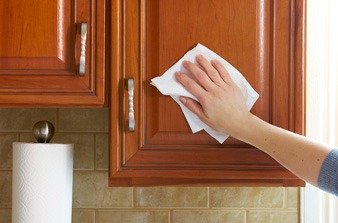Cabinet cleaning Techniques will be the same whether you are working on a kitchen, bath, or storage space. But you may have to budget different amounts of time dependent on the room. Kitchen cabinets, for instance, face constant challenges from dirt, grease, bacteria, and even fingerprints. Grease from cooking or cooking sprays, condensation from temperature changes and steam, and grime and bacteria from food and hands may stain and damage cabinet exteriors.

If You've Got a busy kitchen, some cupboards may Have to be wiped clean once a day. Others may need only a weekly cleaning. Remember to clean around handles and close to appliances. Use these kitchen cabinets deer park tips to customize your cleaning regimen based on cabinet materials.
Wood Cabinets
Cabinets might be Solid timber, veneer over wood, or vinyl-coated wood. The wood may be sealed with wax, polyurethane, or sponge, or left natural. Care is determined by the surface treatment. General-purpose oil-soap timber cleaners work well for overall maintenance. No matter the sealant, often clean and wax or polish your wood cabinets. Heat and temperature changes can dry wood. Wood cabinets may also be damaged by condensation brought on by steam from cooking and dishwashers. Wipe closets dry. Don't get wood overly wet. Occasionally disinfect all surfaces with a diluted antibacterial cleanser without bleach. Wipe on, then rinse with a clean, moist cloth. Dry using a third cloth. Work with the grain of the timber when cleaning and polishing.
Painted cabinets that Are sealed with one or more coats of oil-base paint are far more durable -- and therefore more scrubbable -- compared to latex-painted wood. Wash painted cabinets with warm water and diluted all-purpose cleaner, wood cleaner, or white vinegar. Don't get the wood excessively wet. Rinse the surface with a second cloth and wash water.
Wipe regions that might be
If Grease builds up, wipe the cabinets with water and ammonia. Rinse with clear water. Soda and water.




















